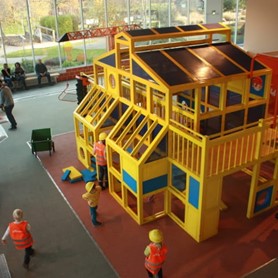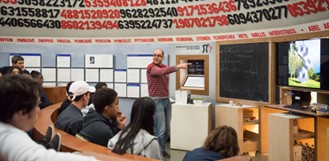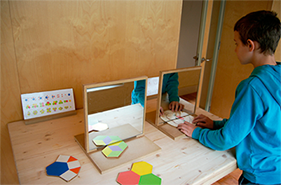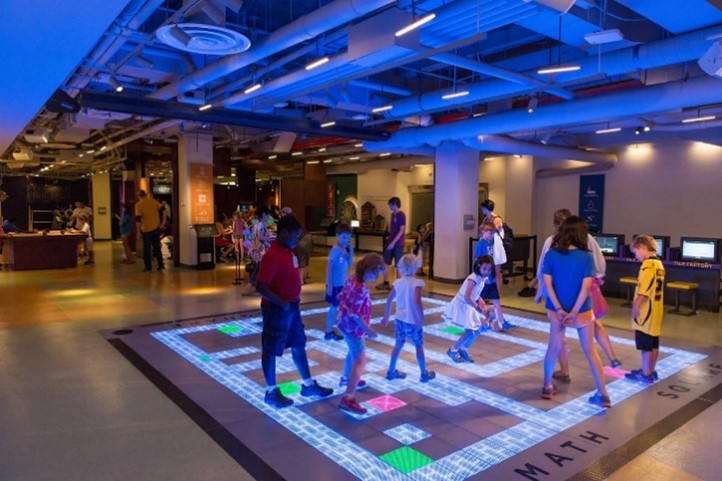There are several cultural centres dedicated to mathematics in Europe and around the world.
To name but a few : The Archimedes Garden in Florence (Italy), the Maison des Mathématiques et de l’Informatique in Lyon (France), the MoMath in New York (United States) or the Mathematikum in Giessen (Germany), the MMACA in Barcelona (Spain) and soon the Maison Poincaré in Paris (France) and the Maison de Fermat in Beaumont de Lomagne (France) and many others, come together in many ways.
Several scientific centres also have rooms dedicated to mathematics.

In fact, “these museums” claim to democratise mathematics in order to make it accessible to all, regardless of age, social background or educational background. The aim is to bring mathematics to life through activities linking object manipulation and reflection on different themes such as logic, geometry or even numbers.
Mediation around an exhibition
According to Peyrin (2012), mediation in museums includes all services that accompany visitors, such as guided tours, lectures, workshops and exhibitions. This definition is quite pragmatic but it can be extended in a more idealistic way as F. Contenot or D. Jacobi :
In the museum, mediation serves as an intermediary between the place, the object and the public. It participates both in the development of the collections and in accompanying the visitor. It also ensures an informal educational mission and is part of a knowledge-sharing process. Mediation encourages the visitor to observe and take a stand, so as to lead him or her to autonomy and deeper understanding.
(F. Contenot, 2011)
Mediation corresponds to all forms of cultural intervention organised for visitors. It is mediation insofar as it is situated between the heritage and the public, with the aim of contributing to the pleasure of discovery or a time of enjoyment, as well as facilitating the application of knowledge.
(D. Jacobi, 1999)


Two types of mediation can be distinguished : direct mediation and indirect mediation.
1. Direct mediation, which involves the physical presence of the mediator.

Indirect mediation is carried out without the presence of a mediator, at least physically, since the mediation is carried out through several tools such as descriptive panels, materials to be handled.

The different mediation media must be rich enough and offer various forms to win over and be accessible to a maximum number of people. They must also “anticipate” visitors’ expectations as much as possible, both in terms of content and in their approach, in order to accompany them in a relevant manner.
These various forms of mediation take the form of accompanying documents (visit booklets, game booklets, etc.), labels and digital media.
How to adapt to the public ?
First of all, cultural mathematics centres choose the type of exhibition they wish to create. It can be permanent, temporary or travelling.
For a permanent exhibition, the chosen theme must be sustainable over time. It should be presented for between 5 and 10 years. The exhibition should avoid topical subjects that risk becoming obsolete. The exhibition furniture must be robust.
For a temporary exhibition, its primary purpose is to diversify audiences and maintain visitor interest. It is usually presented for 6 months to 2 years. It can deal with research subjects, experiments that continue to evolve. It encourages visitors to debate. Its furnishings should be up-to-date, original and innovative.
Finally, for a travelling exhibition, its main constraint is travel.
Its purpose is to travel to different centres of mathematical culture and therefore it must be adaptable to different locations. It must be robust to repeated assembly and disassembly.

Adapting to the public requires a good knowledge of its visitors. What are they looking for in a mathematics “museum”? What do they want to discover? To do this, it is possible to survey the public (volunteers, members, visitors) and evaluate their answers, in order to meet the expectations of future visitors and to choose the type of mediation appropriate to the subject.
Adapting to the public means that the exhibition is the direct link between the “museum” and its visitors. It is the trigger for future communication.
Adapting to the audience means keeping in mind that an exhibition should encourage observation, understanding and experimentation.
Finally, for a mathematics “museum”, evaluating the exhibition means maintaining a constant link with the public, questioning them, communicating with them after their visit, and proposing workshops linked to the exhibition to deepen certain notions and debate the subject.